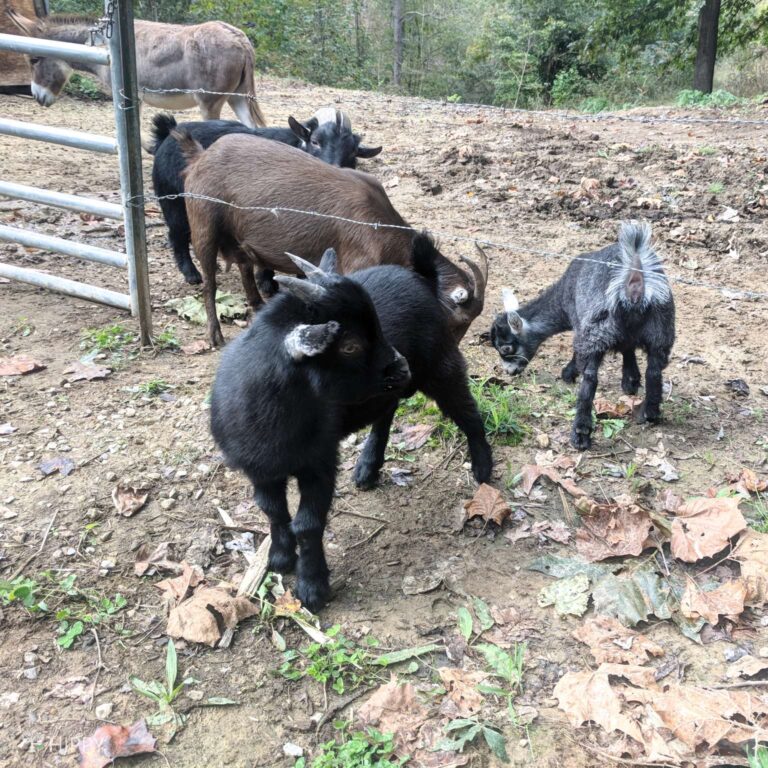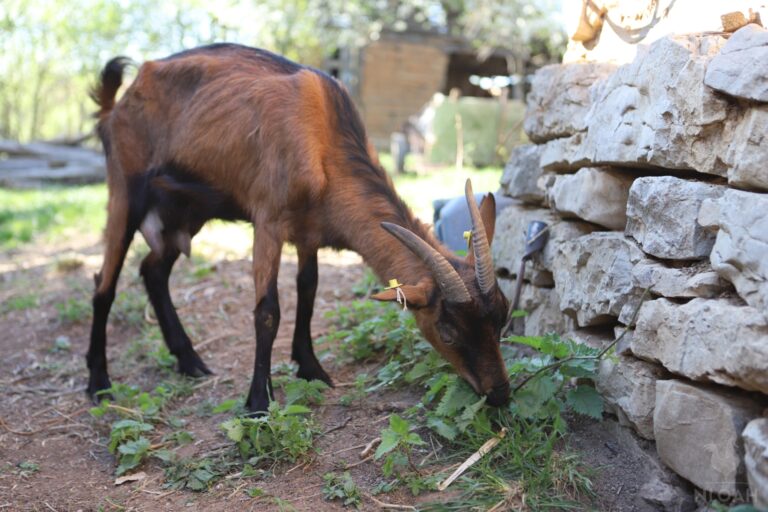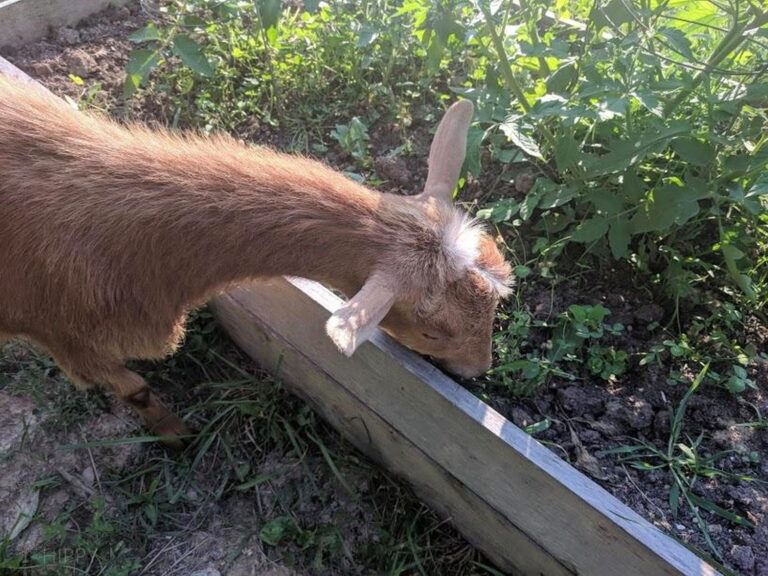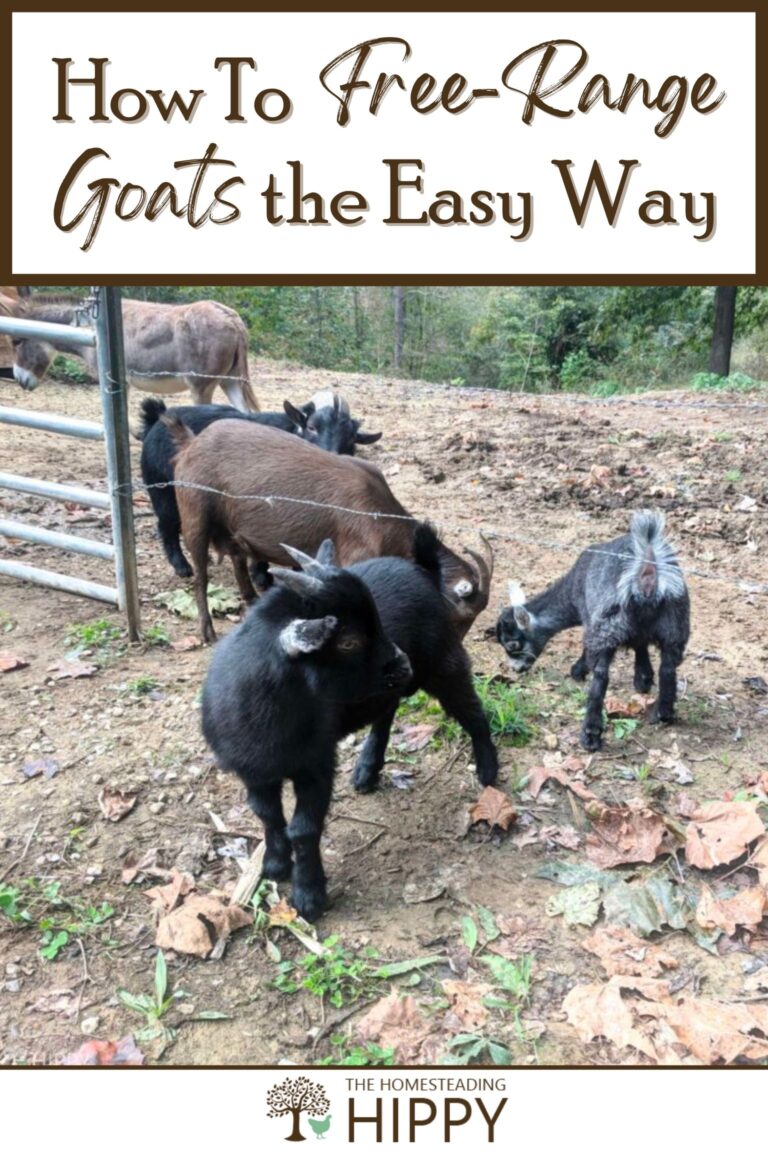When it comes to taking care of our animals, one of the very best things we can do for them is allow them to free range.

Free-ranging is much closer to a natural life for them, and will improve many facets of any animal’s health, including its overall fitness and happiness.
All of this certainly applies for our goats, too. But goats, more than most other livestock species, have a reputation for being incredibly troublesome when free-ranged.
Goats can go virtually anywhere, and their climbing abilities and agility are well-known. This leads most owners to keep them penned up and, hopefully, out of trouble…
But if you want to know the truth, it doesn’t have to be hard to free-range your goats, and you need not tear your hair out to do it if you know some basic procedures and a few simple rules of thumb.
I’ll tell you all about this and a lot more down below, and pretty soon you can free-range your goats without worry…
Prepping Your Property for Free-Ranging
The most fundamental thing you can do to ensure the success of free-ranging your goats is to assess and prepare your homestead.
Done right, you can minimize feed costs, reduce workload, keep your property trimmed, tidy and fertilized and give your goats a life they’ll enjoy.
But done wrong, your animals will go missing, you’ll be stressed out of your mind, and your herd will be more vulnerable to sickness and to predation.
Can’t have that, so take care of the following before you turn your goats loose on your land!
1. Clear Land of Toxic or Dangerous Plants
It’s critical that you take the time to clear your land of any toxic plants that your goats could get to and eat.
While it’s true that goats are pretty good at avoiding toxic plants, you definitely can’t count on this.
It’s up to you to identify, locate and remove these plants and keep them removed if you’re going to allow your goats to free range.
Remember, they will be eating pretty much everywhere as they go; goats are browsers, not grazers, and this means they nibble high and low from all kinds of plants.
This can be especially problematic if you have dangerous plants growing alongside or throughout safe plants that goats like to eat.
Some of the most common dangerous plants for goats include oleander, boxwoods, rhododendrons and hydrangeas, among many others.
If any of those sound familiar to you, you must remove them or contain your goats away from them!
2. Protect Valuable Plants, Surfaces and Vehicles
Ask anyone who has owned goats for any length of time and they’ll tell you that they are among the most adventurous, agile, and mischievous animals that you can own.
Part of this comes from a goat’s natural curiosity, and part from its extraordinary ability to jump and climb.
If they can reach it, goats are going to climb on it or try to nibble on it, and that’s just the way it is.
Goats can absolutely demolish a garden or flowerbeds in no time, as well those fruits and veggies you spent countless hours cultivating or those prized perennials that you adore won’t have long to live if your goats can reach them.
Similarly, goats are notorious for climbing on vehicles and other delicate services, their adorable, tiny hooves scratching and denting with merciless abandon.
Whatever it is, whether natural or man-made, if you want it to be protected, it has to be put up or your goats cannot be able to reach it when they are free ranging.
Otherwise, you must expect them to climb all over it or damage it. You have been warned!

3. Make Sure Your Property is Securely Enclosed
This is the big one. If you were going to allow your goats to free-range, your property must be securely enclosed at the perimeter to contain them, or else you have to set up paddocks that you will move around on your property.
Goats are not like chickens that will generally hang around the place where they sleep and not go too far, returning faithfully as the sun starts to get low in the sky.
Goats can and will wander off, and a goat that starts to take off can easily lead other goats away with it.
Rams that are sexually mature and entering the mating season are extremely prone to running off, either in search of conquests, or following females that have already left.
You need a tall fence for your goats to prevent them from jumping over and one without any gaps that they could pop through or wriggle under.
A better solution is probably electric fencing that will give every goat a strong disincentive to stay away from it after one close encounter.
4. Are There Known Predators in the Area?
Also, ask yourself if there are any known predators in the area that could be a threat to your goats.
Goats are not like chickens or ducks and aren’t vulnerable to the same creatures that they are although they are vulnerable to a few common predators like coyotes, wolves, mountain lions, bears and potentially even packs of feral domestic dogs.
Young kids can also be vulnerable to badgers, bobcats, and similarly-sized animals.
Just because there are predators in the area that might prey on your goats doesn’t mean you can’t free-range them, but you better have a plan for dealing with them.
5. Perform a Nutritional Analysis of Your Pasture
No matter how lush and bountiful your land looks, it’s worth having a proper nutritional analysis performed on it.
This will help you figure out the carrying capacity of your land, how many goats you can keep on it reliably, and also what sort of nutrition you can expect your goats to get from it.
If your land has lots of plants that your animals need, you’ll have to do very little supplemental feeding of your herd, at least for most of the year.
On the other hand, if your land doesn’t have much to offer your goats in the way of consistent nutrition, you’ll need to feed them as usual and consider any additional nutrition they get from your land as incidental.
If you have been relying on goat feed (pellets or otherwise) prior to free-ranging, you can usually continue to feed that to your herd with quantities adjusted based on how much they are eating from the land.

How to Free-Range Goats Successfully
With your land prepared for the free-ranging of your herd, there are still a few other things you should do to make sure your goats stay safe, happy and healthy with their new lifestyle.
1. Consider Bells or GPS Collars
Not strictly necessary if you have a property where your goats will always be in view, but still not a bad idea in case they happen to get out.
There’s a reason why livestock bells have been used for so many centuries: not only will they let you keep track of your goats when they are out of sight, but the nature of the noise they make can give you some insights into what your goats are currently doing.
If they are quiet or gently clanking, your goats are still or walking along.
Loud, urgent ringing, especially many at once, indicates your goats are running in a group, maybe running away from something or someone. Either could be cause for investigation…
If you don’t like the idea of making your goats wear bells which might upset them or interfere with their freedom of movement, you can consider the modern equivalent of GPS tracker collars. Lightweight, low profile, and noise-free!
2. Be Ready to Supplement Feed as Needed
As detailed above, your pasture might not supply everything that your goats need nutritionally. It follows then that you must be prepared to give your goats supplemental feed from time to time.
However, this should be done with an eye towards their calorie requirements, and also with discretion considering what they have been eating on your land.
If a goat’s diet changes too much, too quickly, it can induce bloat or other digestive maladies.
3. Get Your Goats into a Routine with Food and Treats
If you like the idea of being able to put up your goats in a smaller pen, barn, or some other shelter as the day winds down, it’s in your best interest to get them into a routine early on.
The best way to do this, and pretty much the only way to do it, is with food as you probably suspected already!
Goats are incredibly motivated by food, and one of the best ways to get them to come to you for any reason is to shake a can, bag or some other container that will make a distinctive noise and is associated with their favorite treats. Very literally, it’s like ringing the dinner bell!
Done consistently, this is a great way to call your goats in for a dedicated meal time, or just to put them up in the evening.
4. Keep an Eye on Pasture Condition
Like I alluded to above, goats can do a lot of damage to vegetation in a very short period of time. They will happily eat some plants right down to the ground!
Accordingly, you need to inspect your pasture periodically to see how it’s holding up.
If you let your goats to over browse, if you’re keeping too many goats on too small a parcel, or if your land simply doesn’t have enough choice food for goats, they will start to deplete it.
At this point, vegetation will regrow slowly if at all, and your goats, of course, will have less calories and nutrition available.
You can prevent this depletion from occurring by “rotational browsing”: sectioning your land into paddocks with livestock barriers or temporary electric fencing.
Rotated strategically throughout the year, this allows your animals to browse freely while giving the rest of your land a rest so that it can regrow.
Should You Free-Range Pregnant Does?
One of the most common questions I see brought up concerning the free-ranging of goats is whether or not you should allow pregnant does to stay out on the range, or keep them separate from the rest of the herd.
If you know, or have a reason to suspect, that one of your does is pregnant, there’s no harm in letting her free-range for a time.
But as she comes closer and closer to her due date, I prefer to put her in a small pen with a birthing shed on it so she can have shelter, privacy and freedom from unwanted interruptions.
This is also a good thing for you if you need to step in and help out, because you won’t be trying to keep other goats and other animals away.
Yes, many domestic species of goats will kid easily on their own, but accidents are always on the table, and you cannot depend on other goats to leave her alone at the moment of greatest vulnerability.
Can You Free-Range Goats with Other Animals on Your Homestead?
For some folks, this is the million-dollar question: can you allow your goats to free-range, meaning cohabitate, with other animals?
The answer is… it depends.
Goats, like all other species, have their own proclivities and their own preferences, this definitely applies to their erstwhile “rangemates”.
Goats are social, and will generally get along with each other and most other species of similar size.
They can even get along with animals that are significantly larger or smaller than they are, but the problems don’t arise until they actually arise if you get my drift.
Goats might get along fine with pigs or sheep, and horses might be completely unbothered by goats, but herd dynamics and individual attitudes can lead to injuries or worse when things do go bad.
For instance, a horse that decides it’s had enough of a goat pestering it and lashes out might easily inflict fatal damage.
Similarly, goats can easily stress out a chicken with chicks. Squabbles over food are never out of the question.
If you decide to let your various animals free range together, it’s best if they have plenty of room to keep away from each other if desired.
Also, keep your pets in mind, too. Goats are rather infamous for activating the “prey drive” instincts in dogs, especially kids.
Likewise, while most goats won’t have anything to fear from a cat, the presence of a cat could still upset them.
If I were you, I would think long and hard before allowing your trusty dog to run free where the goats are, especially if any of them have kids.

Tim is a farm boy with vast experience on homesteads, and with survival and prepping. He lives a self-reliant lifestyle along with his aging mother in a quiet and very conservative little town in Ohio. He teaches folks about security, prepping and self-sufficiency not just through his witty writing, but also in person.
Find out more about Tim and the rest of the crew here.
